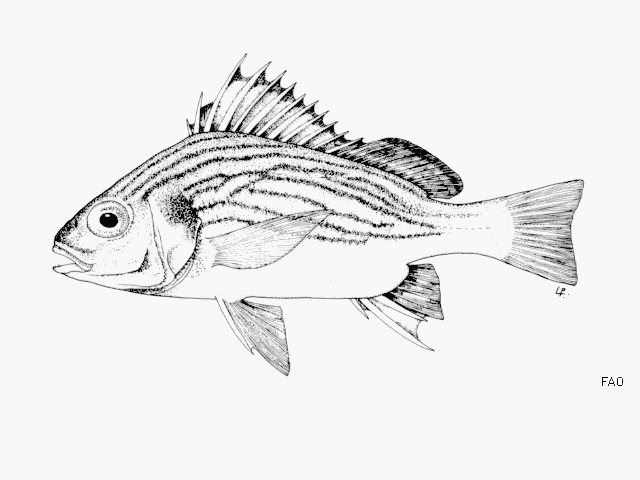Pomadasys
argenteus
(Forsskål,
1775)
Silver grunt
View all media / Upload your photos and videos
Expand all
Classification / Names
Teleostei (teleosts) > Eupercaria/misc (Various families in series Eupercaria) >
Haemulidae (Grunts)
> Haemulinae
Etymology: Pomadasys: Greek, poma, -atos = cover, operculum + Greek, dasys = with hair (Ref. 45335).
More on author:
Forsskål.
Environment / milieu / depth range / climate zone / distribution range
Distribution
Maps

Pomadasys argenteus / Native range
AquaMaps Data sources:
GBIF
OBIS
This map was computer-generated and has not yet been reviewed.

Pomadasys argenteus / Suitable habitat
AquaMaps Data sources:
GBIF
OBIS
This map was computer-generated and has not yet been reviewed.

Pomadasys argenteus / Point map
AquaMaps Data sources:
GBIF
OBIS
This map was computer-generated and has not yet been reviewed.

Pomadasys argenteus / Year 2050
AquaMaps Data sources:
GBIF
OBIS
This map was computer-generated and has not yet been reviewed.
Size / Weight / Age
Short description
Dorsal spines (total): 12; Dorsal soft rays (total): 13 - 14; Anal spines: 3; Anal soft rays: 7. Body ovate; head profile almost straight. Mouth small; lips not thickened; two pores and a central groove under the chin. No antrorse spine before the dorsal fin origin; notch between the spinous and soft-rayed portion of the dorsal fin shallow. Color is generally silver-mauve to fawn above, white below. Small specimens with numerous spots aligned horizontally or fused into horizontal lines; large specimens plain or with scattered charcoal scale spots on back and upper sides; the snout is dark brown; the upper operculum charcoal or purplish.
Biology
Life cycle and mating behavior
Oviparous, distinct pairing during breeding (Ref. 205).
Main reference
McKay, R.J. 1984 Haemulidae. In W. Fischer and G. Bianchi (eds.) FAO species identification sheets for fishery purposes. Western Indian Ocean (Fishing Area 51). Vol. 2. FAO, Rome. pag. var. (Ref. 3412)
IUCN Red List Status (Ref. 125652)
Least Concern (LC); date assessed: March 20 2011
CITES (Ref. 131153)
Not Evaluated
CMS (Ref. 116361)
Not Evaluated
Threat to humans
Harmless
More information
- Countries
- FAO areas
- Ecosystems
- Occurrences
- Introductions
- Stocks
- Ecology
- Diet
- Food items
- Food consumption
- Ration
- Common names
- Synonyms
- Metabolism
- Predators
- Ecotoxicology
- Reproduction
- Maturity
- Spawning
- Spawning aggregation
- Fecundity
- Eggs
- Egg development
- Age/Size
- Growth
- Length-weight
- Length-length
- Length-frequencies
- Morphometrics
- Morphology
- Larvae
- Larval dynamics
- Recruitment
- Abundance
- References
- Aquaculture
- Aquaculture profile
- Strains
- Genetics
- Allele frequencies
- Heritability
- Diseases
- Processing
- Mass conversion
- Vision
- Pictures
- Stamps, Coins Misc.
- Sounds
- Ciguatera
- Speed
- Swim. type
- Gill area
- Otoliths
- Brains
Estimates based on models
Preferred temperature (Ref. 123201): 23.2 - 28.5, mean 27.4 °C (based on 853 cells).
Phylogenetic diversity index (Ref. 82804): PD50 = 0.5 [Uniqueness, from 0.5 = low to 2.0 = high].
Bayesian length-weight: a=0.01380 (0.01117 - 0.01706), b=2.98 (2.94 - 3.02), in cm total length, based on LWR estimates for this species (Ref. 93245).
Trophic level (Ref. 69278): 3.5 ±0.3 se; Based on diet studies.
Resilience (Ref. 120179): Medium, minimum population doubling time 1.4 - 4.4 years (K=0.2-0.5; tmax=19).
Fishing vulnerability (Ref. 59153): Low to moderate vulnerability (31 of 100).
Climate vulnerability (Ref. 125649): Very high vulnerability (81 of 100).
Price category (Ref. 80766): High; Reliable: based on ex-vessel price for this species.
Nutrients (Ref. 124155): Calcium = 96.2 [20.9, 182.9] mg/100g; Iron = 0.981 [0.516, 1.813] mg/100g; Protein = 18.9 [17.0, 20.6] %; Omega3 = 0.238 [0.127, 0.403] g/100g; Selenium = 65.1 [37.7, 117.0] μg/100g; VitaminA = 13.5 [6.4, 26.2] μg/100g; Zinc = 1.11 [0.80, 1.56] mg/100g (wet weight);










